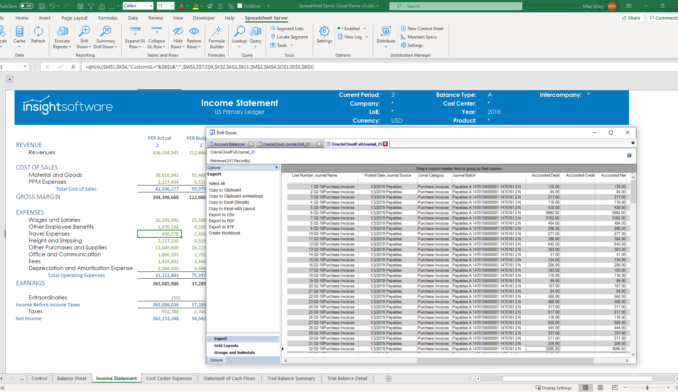SAP TechED 2017: The Cloud Gathers, But Do Customers Approve?
At the recent SAP TechEd in Las Vegas, SAP’s emphasis was obvious: its cloud offering for S/4HANA, the ERP system built on SAP’s proprietary Operational Database System and the HANA in-memory computing platform. This topic was somewhat out of sync with customers at the event, who seemed more interested in the on-premise S/4HANA option, although it did shed light on SAP’s internal roadmap. Other topics of note at the annual gathering for SAP developers, customers, and partners were SAP Business Planning and Consolidation (BPC) Version 11.0, ABAP for the Cloud and BusinessObjects Analysis for Microsoft Office.
Cloud Focus Muddies the Upgrade Waters
Just when existing customers of SAP R/3, which celebrates its 25th anniversary this year, have begun to fully understand SAP’s direction and plot their own internal technology roadmaps, SAP has jumped 10 years ahead by focusing on S/4HANA in the Cloud. This directly contrasts with last year’s TechEd, where SAP’s push was on-premise S/4HANA. The disconnect between SAP and its customers was readily apparent at this year’s TechEd, where session attendance for topics surrounding S/4HANA on-premise were 10 to 20 times higher compared with S/4HANA Cloud and SAP Cloud Platform (SCP), its platform as a service (PaaS) offering.
In recent years, SAP has taken a bit of a beating for looking like a dinosaur by intensely focusing on the S/4HANA on-premise offering, so now it seems to be sprinting in the opposite (cloud) direction. What it has inadvertently created after years of massive marketing is a customer base that’s finally warmed to on-premise S/4HANA as the pathway after R/3, but who now has to weigh another, even less comfortable option. While new SAP customers may more readily adopt the cloud model, it’s a much bigger mental leap for existing SAP customers who already have a massive on-site server infrastructure.
Another major cloud-related development is SAP’s continued adoption of the Open API Initiative. To facilitate the development of application programming interfaces (APIs), SAP is launching two distinct software development kits (SDKs) to facilitate development of applications on both the S/4HANA Cloud and SAP Cloud Platform.
While these cloud-based offerings are quite exciting and demonstrate SAP’s forward-thinking vision, the timing of the emphasis serves to somewhat muddy the waters for existing SAP R/3 customers charting their upgrade course. There are certainly a substantial number of SAP customers who may never embrace a cloud-based solution due to a mix of several concerns: control, compliance, latency, etc. For customers like this, there were rumblings among TechEd attendees of an emerging hybrid approach that will split the difference between on-premise and the Cloud, but details were scarce as it’s a new and highly variable concept.
Crowd Favorite: ABAP in the Cloud
Perhaps the most exciting announcement from SAP at TechEd was the future availability of Advanced Business Application Programming (ABAP) in the SAP Cloud Platform for 2018. This announcement allows SAP customers to leverage existing ABAP knowledge to develop and run ABAP applications in the Cloud. This single announcement was received by far with the most enthusiasm from the TechEd attendees because it represents both a time and cost savings. SAP customers have a great deal of custom ABAP code they’ve developed over the years, as well as an army of developers who are proficient in the coding language. This will allow them to transform existing ABAP custom code so it can be leveraged in a cloud environment, as well as to develop new code in the language they already know.
BPC Version 11.0: Driver for BW/4HANA?
A major announcement from last year’s TechEd was the release of BW/4HANA, a replacement for SAP’s 20-year-old business warehouse (BW) architecture. At this year’s event, SAP focused on perhaps its first major driver for implementing BW/4HANA, which is BPC Version 11.0. The drawback, paradoxically, is that BPC 11.0 does require the upgrade to BW4/HANA—both of which are major projects.
Financial Reporting, BPC, and Analysis for Office
As SAP continues to add and enhance offerings for financial reporting, a core issue still exists: lack of finance user self service. In conversations with customers using either BPC or SAP BusinessObjects Analysis for Microsoft Office to serve their Microsoft Excel-based reporting needs, these tools remain IT-centric. At best, there are a handful of business super users who can independently create reports to a limited extent, which is in direct contrast with other Excel-based reporting tools that let average business users act as both report developer and report consumer.
There was some excitement over new features like custom/local hierarchies and asymmetric reporting on the Analysis for Office road map, but this was overshadowed by fears of increasing instability within the product. Additionally, much of the instability comes when using Analysis for Office in an S/4HANA environment, which means that when a bug occurs in Analysis for Office, it usually requires an S/4HANA upgrade to fix the bug—a major IT project.
Additionally, the perception from customers using SAP’s Analysis for Office was that SAP is prioritizing features over stability. It was common to hear from SAP customers wishing they were still on an older version of Analysis for Office because of instability like general latency, Excel crashes, and strange add-in behavior. Analysis for Office also was of concern due to issues like where it sources data, and looking like—but not behaving like—native Excel. Lack of flexibility was another problem, in that its reports are defined by rows and columns resulting in rigid table outputs instead of cell-by-cell formula-based functions like other Excel add-ins used for reporting.
S/4HANA Still on the Move
An overall takeaway from SAP TechEd 2017 is that customers seem much further along in adopting S/4HANA this year than they did at last year’s event. The migration path is still risky and brings with it some horror stories, but the risk is gradually declining as the product matures and becomes more stable.
This reduced, but still prevalent, migration risk in the ECC to S/4HANA upgrade was quite delicately summarized by SAP itself during an S/4HANA road map session: “I think we have that under control now.” While the statement is somewhat equivocal, it is significant, as it both acknowledges the difficulties the company has had, as well as the improvements it has made. Many customers have already opted for the incremental approach of swapping out their existing database for a HANA database and saving the application migration from SAP ECC to SAP S/4HANA for a later date. But, this is progress nonetheless.
Interested in taking your SAP reporting up a notch? Contact insightsoftware today.







